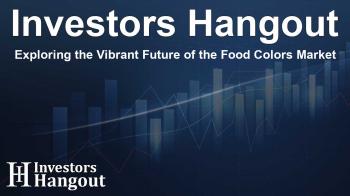Exploring the Vibrant Future of the Food Colors Market

Introduction to the Food Colors Market
The global food colors market is experiencing a vibrant transformation as consumer demands shift significantly. The trends in processed foods, evolving preferences, and stricter regulations contribute to the market's growth. Experts project the food colors market to escalate from USD 4.6 billion in recent years to a remarkable USD 6.0 billion by 2028, reflecting a compound annual growth rate (CAGR) of 5.4%.
Importance of Food Colors Today
Food colors have transcended their role as mere aesthetic enhancements; they now significantly influence consumer choices. Processed foods often undergo various thermal and non-thermal treatments that can impact their natural appearance. To offset this, manufacturers are increasingly employing food colors to restore visual appeal and ensure consistency across products.
In our visually driven society, especially with the rise of social media platforms, presentation is paramount. Studies indicate that around 64% of consumers prioritize the appearance of food when making purchasing decisions. Brightly colored products captivate consumer attention and resonate particularly well with younger demographics, proving that colors are an essential component in brand differentiation.
Natural Food Colors - The Emerging Trend
The market is witnessing a notable shift toward natural food colors, which are anticipated to become the largest and fastest-growing segment by 2028. Consumers are progressively leaning toward clean-label, eco-friendly options, which has led to a heightened acceptance of natural colorants derived from fruits, vegetables, and plants.
Some popular natural colorants currently favored include:
- Carmine
- Anthocyanins
- Caramel
- Annatto
- Carotenoids
- Chlorophyll
- Spirulina
Due to regulatory scrutiny, the usage of synthetic colors is declining in many markets, further boosting the growth of natural alternatives.
Regional Insights into Market Trends
Asia Pacific's Growth Potential
The Asia Pacific region is set to experience the highest market growth, being fueled by expanding economies and rising disposable incomes. Nations like China, India, and Japan are observing an increased demand for ready-to-eat and convenience foods, driving the need for food colors. Local producers are innovating to satisfy the diverse preferences of consumers in this region.
Europe as the Leading Market
Currently, Europe holds a dominant position in the food colors market and is projected to retain its leadership in the coming years. The region's vast food and beverage sector, combined with a strong inclination toward natural and sustainable products, amplifies demand.
With over 291,000 food and beverage processing establishments and high per-capita food expenditure, Europe represents a robust market filled with opportunities. In addition, stringent regulations surrounding synthetic additives encourage a shift toward natural colorants.
Key Players in the Food Colors Industry
Key companies that are significantly influencing the food colors market include:
- ADM (US)
- Sensient Technologies Corporation (US)
- DDW (US)
- DSM (Netherlands)
- International Flavors & Fragrances, Inc. (US)
These industry leaders are dedicated to innovation, sustainability, and offering clean-label alternatives to meet the evolving expectations of consumers. The food colors market stands at the intersection of health trends, consumer behaviors, and innovative practices. With natural colorants rising to prominence and regions like Asia Pacific showcasing substantial growth potential, the future is indeed bright and colorful for this industry.
Frequently Asked Questions
What drives the growth of the food colors market?
Growth is driven by increasing demand for processed foods, changing consumer preferences, and regulatory pressures favoring natural ingredients.
Which segment of food colors is expected to grow the fastest?
Natural food colors are projected to be the largest and fastest-growing segment in the market due to consumer preferences for clean-label products.
How significant is the influence of social media on consumer choices?
Social media plays a critical role in shaping consumer choices, as the presentation and appearance of food are highly valued by consumers.
What regions are leading in the food colors market?
Europe currently leads in the market, while Asia Pacific is anticipated to witness the fastest growth due to rising demand for convenience foods.
Who are the major players in the food colors industry?
Major players include ADM, Sensient Technologies, DDW, DSM, and International Flavors & Fragrances, which are focused on innovation and sustainability.
About The Author
Contact Olivia Taylor privately here. Or send an email with ATTN: Olivia Taylor as the subject to contact@investorshangout.com.
About Investors Hangout
Investors Hangout is a leading online stock forum for financial discussion and learning, offering a wide range of free tools and resources. It draws in traders of all levels, who exchange market knowledge, investigate trading tactics, and keep an eye on industry developments in real time. Featuring financial articles, stock message boards, quotes, charts, company profiles, and live news updates. Through cooperative learning and a wealth of informational resources, it helps users from novices creating their first portfolios to experts honing their techniques. Join Investors Hangout today: https://investorshangout.com/
The content of this article is based on factual, publicly available information and does not represent legal, financial, or investment advice. Investors Hangout does not offer financial advice, and the author is not a licensed financial advisor. Consult a qualified advisor before making any financial or investment decisions based on this article. This article should not be considered advice to purchase, sell, or hold any securities or other investments. If any of the material provided here is inaccurate, please contact us for corrections.

